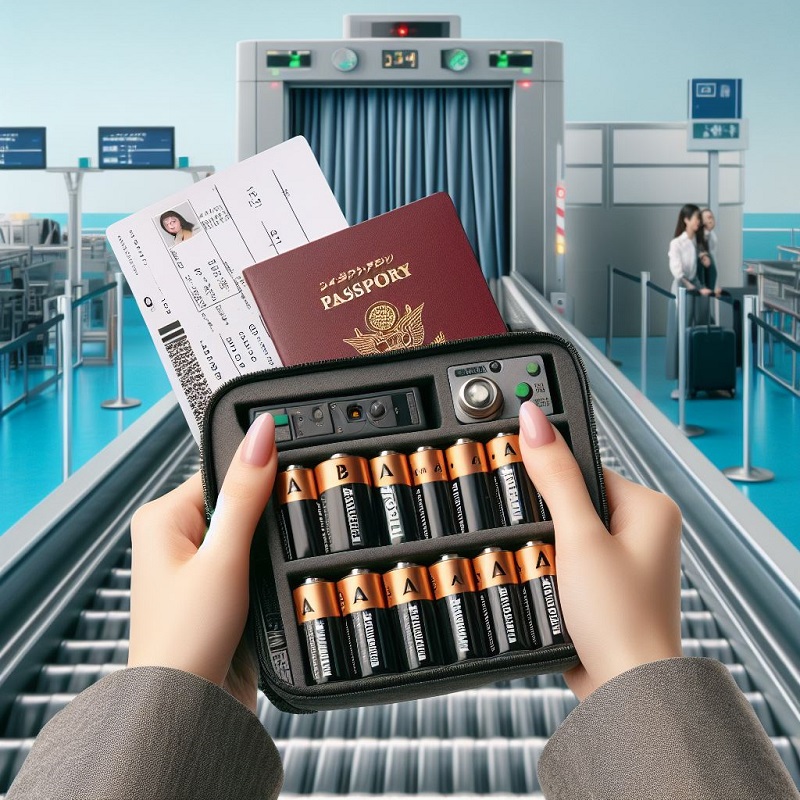Traveling by plane often involves packing various electronic devices, many of which rely on batteries to function. Whether you’re carrying spare batteries or traveling with devices powered by them, it’s crucial to understand the regulations regarding battery transportation to ensure a smooth journey without any surprises at the airport security checkpoint.
Can You Bring Batteries on a Plane?
Yes, you can bring batteries on a plane. However, there are restrictions and guidelines you need to follow. It’s generally allowed to bring batteries in your carry-on luggage, but some types, like lithium-ion batteries, may have limitations on size and quantity.
It’s recommended to keep them in their original packaging or a protective case to prevent short circuits. Spare batteries must be carried in your carry-on luggage and not checked baggage. It’s always a good idea to check with the airline and transportation security administration for specific regulations before traveling.
Can you bring AA Batteries on a Plane?
Yes, you can bring AA batteries on a plane. However, there are restrictions on the quantity and how you pack them. It’s generally recommended to carry them in your carry-on luggage rather than checked baggage. Make sure they’re properly stored in their original packaging or a separate case to prevent short circuits. Airlines and airport security may have specific guidelines, so it’s wise to check with them before traveling.
Are alkaline batteries allowed in checked baggage?
Yes, generally alkaline batteries (AA, AAA, C, D, etc.) are allowed in checked baggage. But:
- Protect them: Ensure they’re insulated and can’t damage each other or create sparks/heat.
- Check with your airline: Some have stricter rules, so confirm with them for peace of mind.
- Carry-on preferred: While allowed in checked baggage, carrying them in your carry-on is generally safer and more accessible for security checks.
Remember, final say rests with the TSA officer at the checkpoint.
Types of Batteries
When it comes to batteries, there are several types commonly used in consumer electronics. The most prevalent ones include lithium-ion batteries, alkaline batteries, and NiMH (Nickel Metal Hydride) batteries.
Regulations for Lithium-ion Batteries
Lithium-ion batteries are widely used in smartphones, laptops, cameras, and other portable electronics due to their high energy density. However, they are subject to specific regulations when it comes to air travel.
Quantity Restrictions
Airlines typically limit the number of lithium-ion batteries a passenger can carry, both in their carry-on luggage and checked bags. These restrictions are in place to minimize the risk of fire hazards associated with these batteries.
Carry-on vs. Checked Luggage
In most cases, lithium-ion batteries must be packed in carry-on luggage rather than checked bags. This is because the cargo hold of an aircraft is not equipped to handle potential fires caused by lithium-ion battery malfunctions.
Packing Requirements
When carrying lithium-ion batteries, it’s essential to ensure they are properly packaged to prevent short circuits. This often means keeping them in their original packaging or placing them in individual plastic bags to prevent contact with other metal objects.
Alkaline Batteries and NiMH Batteries
Unlike lithium-ion batteries, alkaline batteries and NiMH batteries are generally considered safer for air travel due to their lower risk of combustion. However, there are still guidelines to follow when traveling with these types of batteries.
General Guidelines for Carrying
Alkaline batteries and NiMH batteries are typically allowed in both carry-on and checked luggage. However, it’s advisable to keep them in their original packaging or place tape over the terminals to prevent short circuits.
Safety Considerations
Even though alkaline batteries and NiMH batteries pose less of a fire risk, it’s essential to handle them with care to avoid leaks or damage during transit. Storing them in a cool, dry place away from direct sunlight is recommended.
Tips for Traveling with Batteries
To ensure a hassle-free travel experience with batteries, consider the following tips:
- Store batteries securely in your carry-on luggage to prevent damage.
- Avoid packing loose batteries together or near metal objects.
- If traveling with spare batteries, ensure they are fully charged and placed in a separate bag for easy inspection.
- In case of damaged batteries or devices, notify airline staff immediately for assistance.
Common Questions and Concerns
Can you bring spare batteries?
Yes, spare batteries are generally allowed, but they must be packed properly and within the specified quantity limits.
Are there restrictions on battery-powered devices?
Devices powered by batteries, such as laptops and cameras, are allowed on planes, but restrictions may apply to spare batteries.
What if your device has a built-in battery?
Devices with built-in batteries, like smartphones and tablets, are allowed on planes without additional restrictions.
How to handle damaged batteries during flight?
If a battery becomes damaged or begins to leak during flight, notify the cabin crew immediately and follow their instructions for safe disposal.
Are there any specific regulations for international flights?
International flights may have additional regulations regarding battery transportation, so it’s essential to check with the airline before traveling.
Conclusion
In conclusion, traveling with batteries is generally allowed, but it’s essential to adhere to airline regulations to ensure safety for yourself and your fellow passengers. By following the guidelines outlined above and taking the necessary precautions, you can enjoy your journey without any concerns about battery transportation.
